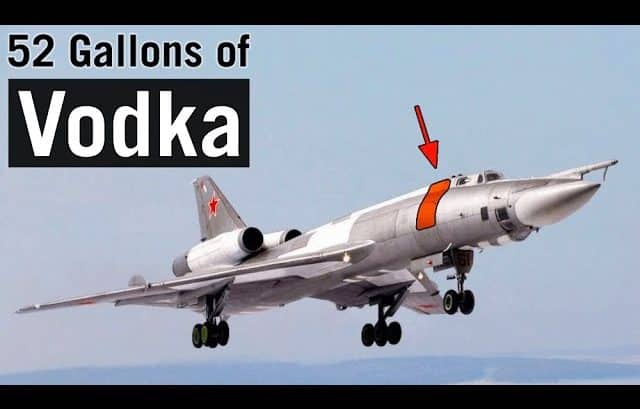Once upon a time, there was an aircraft designed to fly with 52 gallons of Vodka to keep its 3 crewmembers comfortable during the flight. Whatever vodka wasn’t used up during the flight would be divided up between the flight crew and the maintenance crew on the ground. Though it may seem fictional, this was actually a real plane.
Going Supersonic
In the mid-1950s, both the Soviet Union and the United States introduced their first supersonic fighters: the MiG-19 and F-102. This meant that the Soviet’s Tu-16, a subsonic bomber, was now vulnerable to supersonic interceptors. The introduction of surface-to-air missiles would further add another threat to subsonic flight.
After America developed its first supersonic bomber – the B-58 Hustler, the Soviet Union was quick to design its response: the Tu-22.

Developing The Tu-22
Andrei Tupolev decided to make the old Tu-16 design supersonic by doubling its engine count from two to now four turbojets. But as it turns out, making something subsonic into supersonic would require more than adding two jets.
The new engines were placed all the way back, on two sides of the vertical stabilizer, to resolve the unintended pitching it experiences whenever it reached Mach 1. Having the engines at the back had its downsides, however.
It caused the aircraft’s center of gravity to move toward the back, meaning the aircraft had to move fast in order to stay level. If not, its nose would tip up and cause the Tu-22 to stall. This was also the reason why the Tu-22 had to maintain a landing speed of ~220 mph.
Nothing Wrong Here
Before it entered widespread production, the Tu-22 was involved in a fatal crash that would be swept under the rug. During that flight, the aircraft was flying smoothly until it started to reach supersonic speeds. It soon began to vibrate for some time until the crew heard a loud snap. The crew was ordered to eject, but the pilot tried his best to save the aircraft to no avail. Engineers would later find only one reason for the crash: the flutter in the stabilizers during supersonic flight.
Surprisingly, this didn’t stop the Tu-22 from entering production.

The Mean-Eater Nickname
By 1962, around 20 Tu-22s have already been produced even though they were still technically being used for testing. A total of 311 Tu-22s were built but around 70 of those were lost due to accidents. Bad design aside, it was theorized that having only a single pilot may have caused some of these crashes.
After over 30 years of operations, more than 40 crew members have lost their lives, earning the Tu-22 the nickname of “Man-Eater”. There was one thing that worked flawlessly on the Tu-22 though – it ran on 52 gallons of vodka.
Booze Cruise
The comfort level of the crew onboard is important, so having an air-conditioned cockpit is seen as a necessity. Its AC was simple: take hot air from the engine compressor and run it through a tank mixed with 60% distilled water and 40% ethanol.
The alcohol mixture would then absorb the heat and evaporate at 10 gallons per hour of flight, giving cool air inside the cockpit. Upon landing, any leftover vodka would then be drained and distributed between the flight and ground crews. You can’t get any more Soviet than this!



